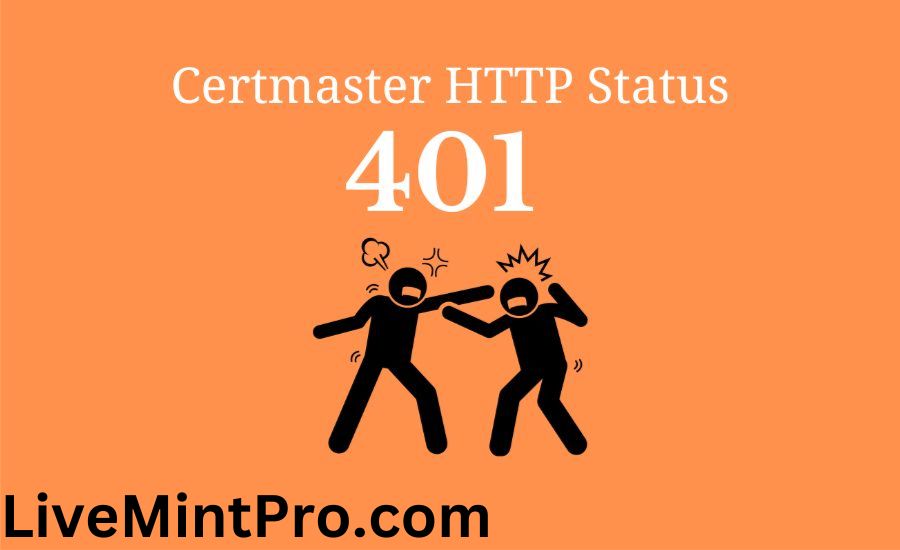When you encounter the CertMaster HTTP Status 401 error, it can feel like hitting a brick wall during your cybersecurity training. This error signifies that your request for access has been denied due to authentication issues. Understanding what this means and how to resolve it is essential for anyone utilizing the CertMaster platform to prepare for IT certifications.
The CertMaster HTTP Status 401 error often arises when users attempt to log in without the correct credentials or when their session has expired. In this blog post, we will delve into the common causes of this error, practical troubleshooting steps, and tips to ensure a smoother learning experience on the CertMaster platform. Let’s turn this technical hiccup into an opportunity to enhance your cybersecurity skills!
Understanding the CertMaster HTTP Status 401 Error
When you see the CertMaster HTTP Status 401 error, it means you are not allowed to access a part of the website. This happens when the server can’t confirm your login information. Think of it like trying to enter a building without the right key. You won’t get in until you show the proper credentials.
This error usually pops up when you try to access your study materials on CertMaster. It’s important to know why this happens so you can fix it quickly. Sometimes, it is because you made a mistake entering your username or password. Other times, your session may have expired after being inactive for a while. Understanding this error can help you get back to studying faster.
Common Causes of CertMaster HTTP Status 401: What You Need to Know
There are a few main reasons why the CertMaster HTTP Status 401 error shows up. The first is incorrect login details. Many people accidentally mistype their usernames or passwords. Always double-check what you entered, especially if you see this error.
Another reason could be session timeouts. If you step away from your computer for too long, the system could log you off automatically. When you come back and try to access the site, you might run into this error. It’s like forgetting to lock the door after you step outside.
Sometimes, cookies and cache in your browser can cause problems, too. These are little pieces of data that help your browser remember things. But if they need to be updated or corrupted, they can interfere with logging in. Cleaning these up often enables you to avoid the error.
How to Troubleshoot CertMaster HTTP Status 401 Errors
If you encounter the CertMaster HTTP Status 401 error, don’t panic! There are simple steps you can take to fix it. First, check your login information. Make sure your username and password are correct. Please pay attention to the capitalization, as it matters!
Next, try clearing your browser’s cache and cookies. This helps remove old data that may be causing issues. Go into your browser settings, find the option to clear browsing data, and select cookies and cached images. After this step has been taken, attempt logging back in again to see if your issue has been solved.
If you still face the issue, restarting your browser can help. Close it entirely before opening it again.You can also try using a different browser to see if that works better. Sometimes, a simple refresh is all you need!
Preventing CertMaster HTTP Status 401: Tips for Smooth Access

To avoid the CertMaster HTTP Status 401 error in the future, there are a few tips you can follow. First, always keep your login details safe and secure. Use a password manager if needed to help remember your passwords. This can prevent mistakes when logging in.
Also, try not to leave the site idle for too long. If you know you’ll be away, log out before stepping away from your computer. This helps keep your account secure and can avoid session timeout errors.
Lastly, stay updated with your browser. Using the latest version can help with compatibility issues. Make sure to update your browser regularly, as this can improve performance and reduce errors. By following these tips, you can have a smoother experience on CertMaster!
You May Also Like: Snapilogue
The Importance of Knowing CertMaster HTTP Status 401 in Cybersecurity
Understanding the CertMaster HTTP Status 401 error is essential for anyone in cybersecurity training. This error is not just a technical glitch; it teaches you valuable lessons about authentication and access control. In cybersecurity, knowing how to identify and resolve errors is crucial. It helps you develop skills that are needed in real-world situations.
This error can act as an early warning signal. When you see it, it reminds you that your credentials are not being accepted. It encourages you to think critically about your access rights and the security of your accounts. Recognizing this can help you prevent unauthorized access and maintain a secure environment.
Furthermore, learning about the CertMaster HTTP Status 401 error can deepen your understanding of how web systems operate. You gain insight into how servers authenticate users and manage sessions. This knowledge is vital for anyone looking to build a career in cybersecurity. It equips you with the tools to tackle similar issues in professional settings.
Real-Life Scenarios: What the CertMaster HTTP Status 401 Teaches Us
The CertMaster HTTP Status 401 error can teach us valuable lessons through real-life scenarios. For instance, imagine you’re preparing for a major IT certification. You log in to access your study materials and suddenly encounter this error. It can be frustrating, but it also serves as a reminder to check your login details.
In another scenario, suppose you’re helping a friend troubleshoot their account. They receive the same 401 error while trying to access their resources. This situation teaches you to consider factors like session timeouts or browser issues. By guiding your friend through the troubleshooting process, you not only help them but also reinforce your understanding.
These real-life situations demonstrate how the CertMaster HTTP Status 401 error can enhance your problem-solving skills. Each time you face this error, it provides an opportunity to learn more about cybersecurity principles and best practices.
When to Contact Support for CertMaster HTTP Status 401 Issues
Knowing when to reach out to support regarding the CertMaster HTTP Status 401 error is important for resolving issues efficiently. If you’ve tried all troubleshooting steps, like checking your credentials and clearing your browser’s cache, but still see the error, it may be time to contact support.
Additionally, if you suspect there might be server issues, reaching out to support can provide clarity. They can confirm if there are ongoing outages affecting users. Understanding these situations can save you time and frustration.
Sometimes, you may notice that the error persists despite following all guidelines. In such cases, the support team can investigate further. They may uncover issues with your account setup or other underlying problems. Being proactive and reaching out for help can make a big difference in your learning experience.
Your Roadmap to Mastering CertMaster Without the 401 Error
To master CertMaster and avoid the CertMaster HTTP Status 401 error, it’s helpful to follow a roadmap. Start by familiarizing yourself with the platform’s login process. Knowing how to navigate the interface will make it easier to identify potential issues.
Next, create a habit of double-checking your login details before you try to access your account. Make sure your credentials are entered correctly and remember to keep them secure. This small step can save you from unnecessary errors.
Another key aspect is to regularly clear your browser’s cache and cookies. Doing this can prevent outdated data from causing login issues. Finally, always stay informed about updates to the platform and any changes to its policies. By following these steps, you can ensure a smoother learning journey on CertMaster.
Conclusion
In conclusion, understanding the CertMaster HTTP Status 401 error is important for everyone using the CertMaster platform. This error teaches us about how authentication works and why we need to keep our login details safe. It’s not just a roadblock; it’s a chance to learn more about cybersecurity and improve our skills. Every time we face this error, we get better at solving problems and keeping our information secure.
Remember, when you encounter this error, don’t panic! There are simple steps you can take to fix it. By checking your login details, clearing your browser’s cache, and knowing when to ask for help, you can overcome the CertMaster HTTP Status 401 error. With these tips, you’ll be well on your way to mastering your studies without any interruptions. Happy learning, and enjoy your journey toward certification!
Stay Updates With: LiveMintPro
FAQS
Q: What does CertMaster HTTP Status 401 mean?
A: The CertMaster HTTP Status 401 error means you are not authorized to access the requested resource. This usually occurs due to incorrect login credentials or an expired session.
Q: How can I fix the CertMaster HTTP Status 401 error?
A: To fix this error, check your login details for accuracy, clear your browser’s cache and cookies, and try logging in again. If the issue persists, restart your browser or use a different one.
Q: What causes the CertMaster HTTP Status 401 error?
A: Common causes include incorrect login information, session timeouts due to inactivity, missing authentication details, or issues with browser cache and cookies.
Q: Is it normal to see the CertMaster HTTP Status 401 error?
A: Yes, it can be normal to encounter this error occasionally, especially if you are inactive for a while or if there are issues with your login information.
Q: When should I contact CertMaster support for the 401 error?
A: You should contact support if you have tried troubleshooting steps but still see the error. They can check for server issues or account problems that might be causing the error.





